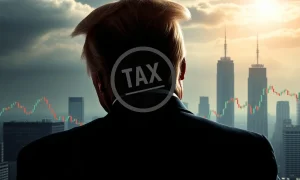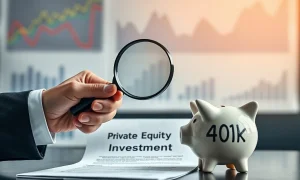Are you feeling an intense urge to join the stock market rally? Perhaps you see others celebrating substantial gains. Many investors experience a powerful mix of fear of missing out (FOMO), envy, and greed. This emotional cocktail often accompanies periods of record stock prices. In fact, these feelings are a significant factor in the formation of **market bubbles**.
Understanding How Market Bubbles Form
A **market bubble** occurs when asset prices inflate significantly. This inflation often detaches from the assets’ intrinsic value. It happens due to rapid price increases. Speculative trading also plays a role. During these times, investor behavior shifts. Rational analysis often gives way to emotional impulses.
Historically, bubbles emerge from a combination of factors. First, innovation or a new economic paradigm creates excitement. Then, initial gains attract more investors. This influx drives prices higher. Subsequently, FOMO sets in for those on the sidelines. They fear missing out on easy profits. Consequently, more money pours into the market. This creates a self-fulfilling prophecy of rising prices. Finally, the bubble bursts. Prices then collapse rapidly.
The Psychology Behind Market Bubbles
Investor psychology is crucial in the lifecycle of **market bubbles**. Human emotions, not just economic fundamentals, drive market movements. Notably, three powerful emotions frequently surface during speculative periods:
- Fear of Missing Out (FOMO): Investors see others profiting. They worry about being left behind. This pushes them to buy assets at inflated prices.
- Envy: Observing peers or competitors achieve significant wealth can fuel a desire for similar gains. This prompts less cautious investment decisions.
- Greed: The prospect of quick, substantial profits overrides caution. Investors take on excessive risk. They ignore warning signs.
These emotions create a feedback loop. Rising prices encourage more buying. More buying further inflates prices. This cycle continues until the market can no longer sustain it. Eventually, a small trigger can cause a sudden and dramatic reversal.
Identifying Signs of Market Bubbles
Recognizing a **market bubble** before it bursts is challenging. Yet, certain indicators often precede a market correction. Investors should watch for these signs carefully. One common sign is a rapid and sustained increase in asset prices. This growth often lacks a clear fundamental justification. For instance, company earnings may not support stock valuations.
Another indicator is widespread speculative behavior. People buy assets purely based on the expectation of selling them at a higher price. They do not consider underlying value. This includes a surge in new, inexperienced investors entering the market. They often seek quick riches. Additionally, public enthusiasm becomes very high. Mainstream media frequently discusses market gains. This broad interest can signal a bubble. Furthermore, debt levels may rise significantly. Investors borrow heavily to fund their purchases. This amplifies risk. Therefore, these combined factors suggest an unstable market environment.
Historical Examples of Market Bubbles
History offers many examples of **market bubbles**. These instances provide valuable lessons. Understanding past events helps identify current risks. Here are a few notable examples:
- The Dutch Tulip Mania (1637): Tulip bulb prices soared to exorbitant levels. People mortgaged homes to buy bulbs. Prices eventually crashed, causing widespread financial ruin.
- The South Sea Bubble (1720): Shares of the South Sea Company, a British trading company, skyrocketed. Speculation drove prices. The bubble burst, leading to a financial crisis.
- The Dot-Com Bubble (Late 1990s): Internet company stocks saw massive valuations. Many companies had little revenue or profit. The bubble burst in 2000. This led to significant losses for investors.
- The US Housing Bubble (Mid-2000s): Housing prices surged, fueled by subprime mortgages. This bubble collapsed in 2008. It triggered a global financial crisis.
These historical events share common traits. They show rapid price increases, speculative fervor, and eventual collapse. Learning from them can help investors navigate today’s markets.
Navigating Current Market Conditions and Market Bubbles
Today’s record stock prices naturally raise questions. Are we in another **market bubble**? No one can predict the future with certainty. However, investors can adopt strategies. These strategies help mitigate risks during volatile times. Prudent financial planning is essential. Diversification remains a core principle. Spreading investments across different asset classes reduces exposure to any single market downturn.
Furthermore, maintain a long-term investment horizon. Short-term market fluctuations become less impactful over many years. Avoid making impulsive decisions based on headlines or social media trends. Instead, focus on fundamental analysis. Evaluate a company’s earnings, debt, and competitive position. Do not chase every hot stock. A disciplined approach protects your capital. It also helps you achieve sustainable growth. Finally, consider consulting a financial advisor. They offer personalized guidance. They help you align your investments with your risk tolerance and goals.
Distinguishing Healthy Growth from a Bubble
Not every period of rising stock prices indicates a **market bubble**. Markets can experience genuine growth. This growth comes from innovation, productivity gains, or economic expansion. Distinguishing healthy growth from a bubble requires careful analysis. Look for strong underlying fundamentals. Are company earnings growing? Are industries developing new, valuable products or services? Sustainable growth often reflects these factors. Bubbles, conversely, show a disconnect. Prices rise without corresponding improvements in company performance. Speculation, rather than value, drives prices. Therefore, focus on the ‘why’ behind price movements. This helps investors make informed decisions.
Conclusion: Staying Rational in Volatile Markets
Record stock prices can certainly trigger powerful emotions. FOMO, envy, and greed are natural human responses. However, succumbing to these feelings can lead to poor investment choices. Understanding the dynamics of **market bubbles** is crucial. It helps investors make rational decisions. Focus on sound investment principles. Prioritize diversification and long-term planning. Conduct thorough research. Avoid speculative frenzies. Ultimately, informed and disciplined investing remains the best defense against market volatility. Protect your financial future by staying calm and analytical.
Frequently Asked Questions (FAQs)
What exactly is a market bubble?
A market bubble occurs when asset prices rise significantly above their fundamental value. This surge is often driven by speculative buying, investor euphoria, and the expectation of quick profits rather than underlying economic realities. Eventually, the bubble bursts, leading to a sharp price decline.
How can I identify if the market is in a bubble?
Several signs may indicate a market bubble. These include rapid and sustained price increases not supported by company earnings, widespread speculative behavior, high levels of public enthusiasm for investing, and increased borrowing to fund investments. However, no single indicator guarantees a bubble.
What role do emotions like FOMO and greed play in market bubbles?
Emotions like FOMO (Fear of Missing Out), envy, and greed play a significant role. FOMO pushes investors to buy assets at inflated prices, fearing they will miss out on gains. Greed can lead to excessive risk-taking, while envy can prompt irrational decisions based on others’ successes. These emotions fuel the speculative frenzy.
What should investors do during a period of record stock prices?
During periods of record stock prices, investors should remain disciplined. Focus on diversification across different asset classes. Maintain a long-term investment perspective. Regularly rebalance portfolios. Avoid making impulsive decisions based on short-term market movements or emotional impulses. Conduct thorough research before investing.
Are all periods of high stock prices considered market bubbles?
No, not all periods of high stock prices are market bubbles. Markets can experience genuine growth driven by strong economic fundamentals, technological innovation, or increased corporate profits. A market bubble is characterized by prices detaching from these fundamentals due to excessive speculation and irrational exuberance.
























